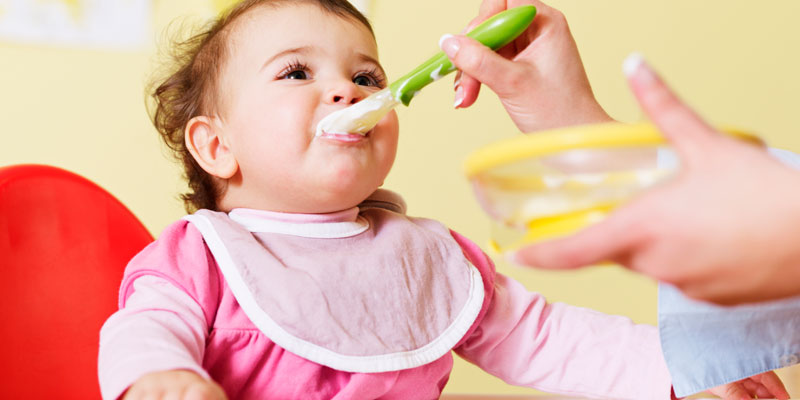
Is Your Baby Ready for Solid Foods?
Up until 6 months of age, “the AAP (American Academy of Pediatrics) recommends that babies be exclusively breastfed.”1 At 6-9 months old, your baby is ready to take a big step in Healthy Food and Eating! This is the age when most parents start adding solid foods to their baby’s diet, though breast and bottle feeding still continue.
Not every child is ready for solid food by 6 months, and some parents believe that it’s better to wait a little longer before starting to wean their baby. There are, however, some indicators1,2t hat can help you decide if your baby is physically ready to start eating:
- He can hold his head and neck up and sit with support.
- His birth weight has doubled.
- He’s interested in watching you eat and what you’re eating. Watch your plate, he may try to grab something from it!
- His food stays in his mouth instead of being pushed out, and he can swallow instead of just sucking.
- He lets you know that he’s hungry for more by wanting more frequent breast or bottle feedings.
If your baby meets the above criteria, it’s time to start thinking about what types of food to introduce. It’s important to start with soft foods that are easy to swallow and that are not common allergens. First foods are usually rice and oat cereals, and then pureed fruits and vegetables, such as apples, sweet potatoes, carrots, pears, and bananas.
Be sure to only introduce one food at a time, and space new foods one to three days apart. This way, if your baby has an allergic reaction, such as a rash, bloating, or diarrhea, you’ll know which food caused it.3,4 These are some of the milder allergy symptoms, but if he experiences something more severe, such as hives or trouble breathing, it’s important to take him to a doctor right away.
At the same time, variety is a good thing! Once you know that a food won’t cause a reaction, offer it together with other foods, or in mixtures.5 Not only does this provide a wider variety of nutrients, but it will help keep things interesting and may help keep your baby from becoming a picky eater. Spices and herbs can also be used to spice up mealtime; try putting sage in squash, ginger in apples, or cinnamon in bananas.5
Once your baby is able to handle purees, you may be able to make things more interesting for him by mashing the foods instead, creating a different texture. The key thing to remember is that his foods will still need to be soft enough for him to gum until a significant number of his teeth arrive, as it’s important to avoid a choking hazard. In addition to only serving appropriate foods, it’s important for your baby to be sitting upright, as opposed to being in a reclined position.3
(SPECIAL OFFER: Sign up for Playful Bee’s Bee Well developmental learning program to give your baby the best start in life. The first 10,000 children enroll for FREE! Sign up today.)
Play Tips:
Do you want to know how you can support your baby’s development of these Healthy Food and Eating skills at this age? It’s easy! Read on for some simple tips to incorporate into your daily play time together.
- Use food to help expand your baby’s vocabulary. As you introduce him to different foods, make sure to say the name of the food, as well as lots of descriptive words about the food. You can also keep pictures of different foods handy, pointing out the difference between the whole food and the cooked food. Keep up the conversation during meal prep as well to help him learn words related to cooking.
- Praise your baby for trying new foods. As with all other learning, your baby craves positive reinforcement in learning new skills and behaviors. When he cooperates and tries new foods during mealtime, offer encouragement by giving him a warm hug, congratulations for being an “adventurous big kid,” and comments on how good his food tastes.
Developmental Milestones:
Has your baby achieved the following Healthy Food and Eating developmental milestones yet? If yes, check off all the skill(s) he has already mastered to date using Playful Bee’s developmental milestones tracker. It’s absolutely FREE and easy to use, just click HERE!
- Coordinates sucking, swallowing, and breathing simultaneously.
(SPECIAL OFFER: Sign up for Playful Bee’s Bee Well developmental learning program to give your baby the best start in life. The first 10,000 children enroll for FREE! Sign up today.)
Sources:
1American Academy of Pediatrics. Breastfeeding Initiatives: FAQs. American Academy of Pediatrics. Retrieved January 18, 2014, from http://www2.aap.org/breastfeeding/faqsbreastfeeding.html.
2Queensland Health (2008). A Healthy Start in Life: A Nutrition Manual for Health Professionals. Queensland Health. Retrieved January 15, 2014, from www.health.qld.gov.au/ph/documents/saphs/hsil_full_doc.pdf.
3Shaw, Gina (2009). A Solid Start: Introducing Baby to Solid Foods. WebMD. Retrieved January 18, 2014, from http://www.webmd.com/parenting/baby/baby-food-nutrition-9/starting-solid-food.
4Gavin, Mary L. (2011). Feeding Your 4- to 7-Month-Old. Kids Health. Retrieved January 18, 2014, from http://kidshealth.org/parent/pregnancy_newborn/breastfeed/feed47m.html#.
5Parenting. 10 Best Ways to Feed Your Baby. Parenting: Family Health 4-1-1. Retrieved January 29, 2014, from http://www.parenting.com/article/best-ways-to-feed-baby?page=0,0.
Playful Bee
Latest posts by Playful Bee (see all)
- Have a Super Fortune Cookie Friday! - February 9, 2018
- All Kinds of Shapes: Your Child Is Learning Simple Shapes, and Drawing Them Too! - November 13, 2017
- Fishing for Sneakers: Create your own Hand-Eye Coordination Fun - November 11, 2017

+ There are no comments
Add yours